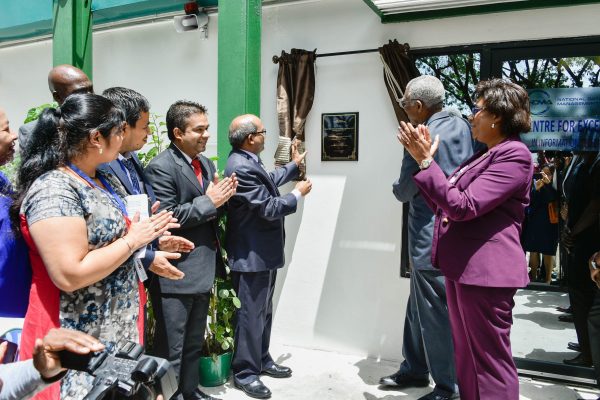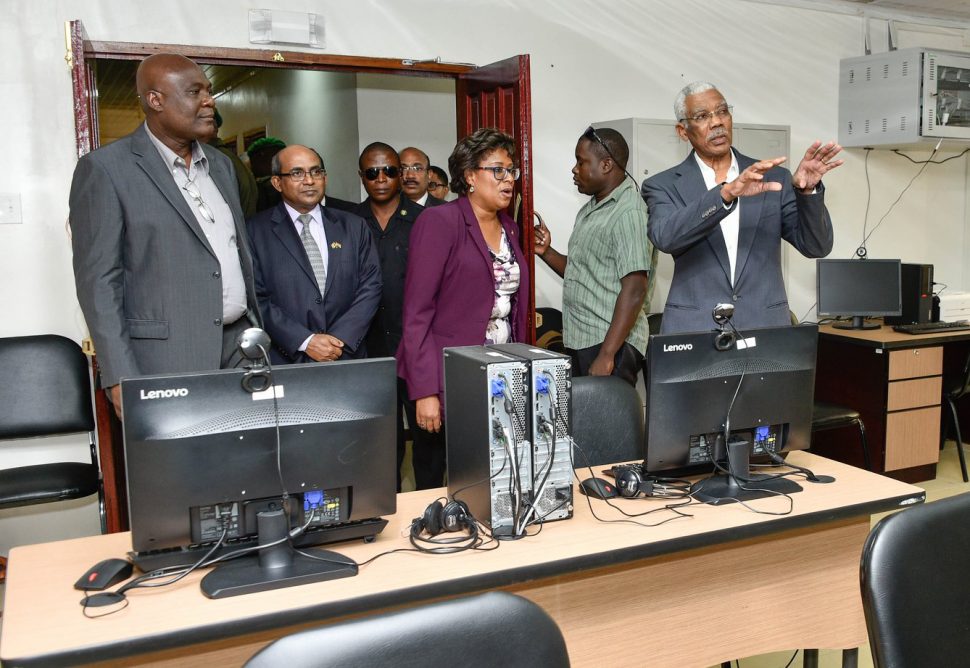The Centre for Excellence in Information Technology (CEIT), which will facilitate advanced level classroom training for public sector Information and communications technology (ICT) professionals, was yesterday commissioned at the University of Guyana’s Turkeyen Campus.
The CEIT is a joint initiative between the Government of Guyana and the Government of India. Initial talks for the Centre commenced in 2017, when a team from the National Data Management Authority (NDMA) and the Ministry of Foreign Affairs met with representatives from India’s Centre for Development of Advanced Computing (CDAC).
Speaking at the commissioning yesterday morning, General Manager of the NDMA Floyd Levi said infrastructure works were completed in February this year, with two laboratories to host 25 students each and one classroom to hold 50 students. “While the Government of Guyana ensured the infrastructure, logistics and operational requirements for the CEIT, the Government of India provided the necessary hardware, such as servers, desktop computers, projectors, printers, scanners and software for setting up two laboratories to support 25 students each and one classroom to accommodate 50 students and over 1,000 reference books in our library,” Levi stated as he gave an overview of the project.

Classes officially commenced at the Centre on April 1st, with CDAC bringing on three Information Technology specialists and two trainers who will stay on for a period of two years to commence training and to oversee the final installation of equipment. The commencement of classes saw a total of 86 public sector professionals being a part of the training. Courses currently offered are Data Communication and Networking, Linux System Administration and Network Security.
According to Levi, a number of other courses will be offered at the Centre over the next year, including Business computing, JAVA Programming, Advanced Web Technologies and a few other courses.
“Even as we commission the CEIT today, I am pleased to report that preparations for a full hand over to local teaching staff have already commenced. One NDMA staff, Mr Denzil Thomas, is currently in India pursuing post graduate studies in IT Infrastructure, Systems and Security through the CDAC programme, with the aim of returning as a master trainer,” he told the gathering.
He added that two other NDMA staff members are expected to pursue post graduate studies. Levi said, three other master trainers will be selected from the public sector and will be trained in India and they will all form the core teaching staff of the Centre.
Levi went on to say that the total budget for the CEIT was set at US$1.5 million, with the Government of India investing US$1 million and the Government of Guyana contributing US$500,000.
Digital State
Delivering the feature address at the commissioning of the Centre, President David Granger told the gathering that the CEIT is a step in the right direction for Guyana as the digital state will benefit from persons being trained in the ICT sector. “The establishment of this Centre of Excellence is a step on the path towards building the human resource capacity that drives the development of the digital state,” the president said.
Granger went on to say that the ICT revolution has begun and the developments in the sector will close the digital divide between the coastland and hinterland regions and between Guyana and the rest of the Caribbean. “The digital state that we are creating will establish a network connectivity linking every person, community and every government agency and ministry. It will ensure that residents of Mabaruma, for example, will not be isolated from residents of Mahdia,” he noted.
Access to broadband internet is currently being rolled out in the remote rural communities and in the hinterland communities and it is expected it will improve access to and the delivery of public services. The president added that broadband access has also been extended to some 116 government agencies and ministries, student dormitories, hostels and three nursing schools, all with the aim of promoting inclusion, social development and citizen engagement.
He further said although things are changing in the country, Guyana is still behind the rest of the Caribbean as it relates to connectivity as Guyana suffers from inequalities along the lines of geography and infrastructural development, which provides challenges for the development of the ICT sector all across the country, especially in the hinterland. “The residents of these communities have to travel long distances to access public services. In fact, incredibly, you may not believe that before we entered office if you were a businessman in Lethem, you had to travel to Anna Regina to register your business,” Granger noted.
“Every court house, every hospital, every police station, every post office, every school and government building, eventually, will enjoy internet access. We have connected over 175 primary schools and 106 secondary schools and 34 technical and vocational institutions to support remote access learning and online research to help students with their academic assignments and homework,” Granger added, while also stating that under the One Laptop per Teacher programme, 8,848 laptops were distributed to teachers.
He added that while Guyana is becoming a digital state, the government aims to establish a network of connectivity, linking communities and agencies across the country and the coastland with the hinterland. “The digital state will deliver quality public services all over the country. It will reduce the need… for citizens to travel outside of their regions of residence in years to come, to access legal services, acquire passports, examine their academic and medical records, record births and deaths, receive social security benefits, register businesses, renew drivers’ licences, file income tax returns and embark on trade and investment enterprises,” the president said.
He further stated that for Guyana to successfully become a digital state, it requires highly trained and skilled persons to push the development of the ICT sector.
“Imagine a country in which children record their notes on tablets on which they can download, retrieve and store information at the click of a mouse instead of in exercise books. Imagine a country with teachers who can teach two classrooms simultaneously—one in Corriverton on the Corentyne and the other in Karasabai in the Rupununi,” Granger said, before telling the gathering that those are not wild imaginations but things currently happening in “today’s world.”
The president expressed gratitude to the Government of India for its assistance in establishing the Centre and its pledged continued support. “This Centre will allow us to become more agile in the ICT sector. It is a prerequisite for a technologically literate and digitally skilled society,” he said.
‘Digitally savvy workforce’
Minister of Public Telecommunications Catherine Hughes, who was present at the commissioning, also expressed her gratitude to the Government of India for its contribution to the development of the ICT sector in Guyana.
Hughes told the gathering that Guyana’s ICT capacity has surpassed what the government had envisioned just three years since her ministry was established.
The minister emphasised that the majority of the ministry’s work so far is focused on connectivity and access to the internet for schools, communities and public sector. “I want to emphasise on the fact that the bulk of the ministry’s work is centred on connectivity, that is, access to the internet for schools, communities through our ICT hubs, for ministries and the public sector to be able to speak better and communicate with each other and for citizens to access government services online,” Hughes said. She went on to say that they are also focused on education and training and they have frequently collaborated with the Ministry of Education, STEM Guyana and other organisations. “Many of you may not know that last year alone, through these partnerships, we have been able to train through our ministry, 650 young people all across Guyana,” Hughes said.
Hughes added that they celebrate the establishment of the Centre as the foundation of the ministry’s strategy, which will ensure “a digitally savvy workforce.” She went on to say that the Centre would ensure that more teachers are trained in the information technology field and technicians, network operators and app developers in the public sector would have the opportunity to gain advanced knowledge and qualifications. “This is a critical foundation on which we want to build a Guyana that is ready to take its place in today’s globalised digital world and this Centre ensures that we are taking our people along on this new path of transformation,” the minister stated.
According to outgoing High Commissioner of India to Guyana, Venkatachalam Mahalingam, the Government of India has opened Centres for Excellence in many other countries. “There is a need to keep pace with the world by educating ourselves about information technology. It is in this regard this Centre of Excellence in Information Technology will play a great role in its own way,” he said.
He added that during the first two years of the Centre being in operation, it is expected that over 500 students will be trained in the various courses offered. Mahalingam further stated that in the future, some trainees would also become trainers and courses will also involve the training of trainers.
He urged the current students and future students to make use of the Centre to its fullest extent and keep the Centre as a true “Centre of Excellence.” Mahalingam expressed his gratitude to the Government of Guyana, Hughes and former Minister of State Joseph Harmon, who had initially commenced talks with for the Centre.






